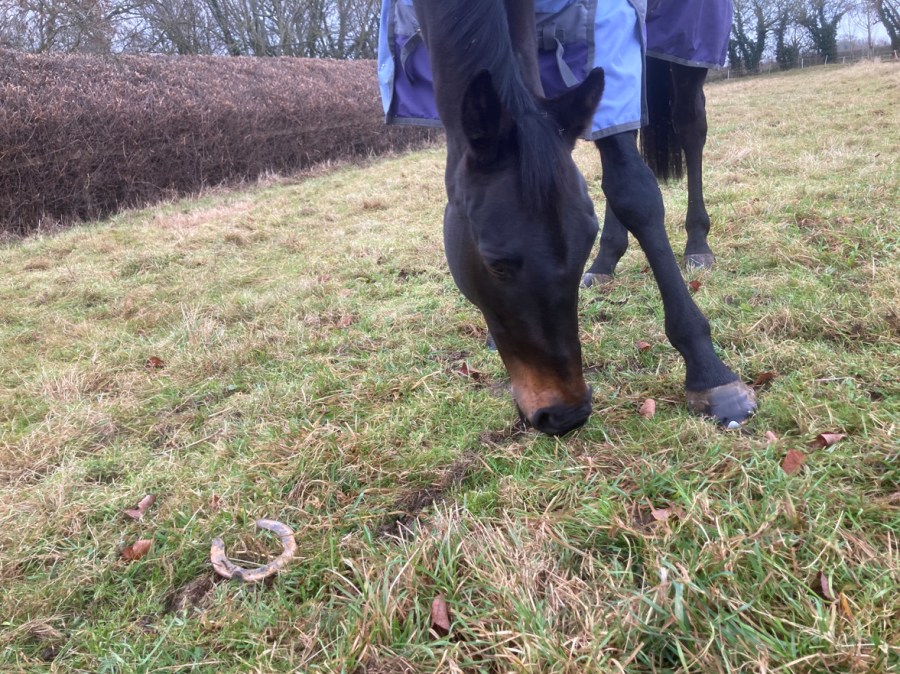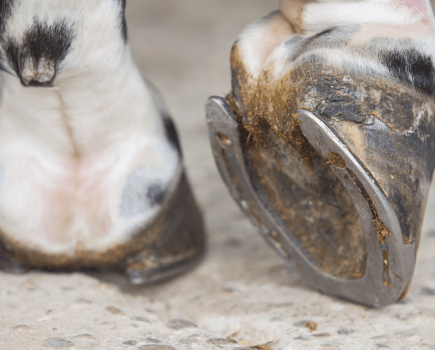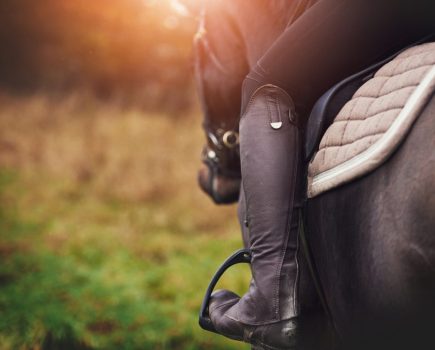Is there anything more annoying than when you get your horse in from the field to ride only to find they have lost a shoe? Your ride is immediately put on the back burner and you have the problem of getting your farrier out ASAP to put it back on — and what to do with the shoe-less hoof in the meantime?
Preventing your horse losing a shoe is an important part of horse hoof care, because it helps to keep hooves healthy.
Lost shoes are a nuisance for horse riders and can result in many missed rides and even lameness if your horse is prone to losing them. Here are five things you can do to help lower the chances of your horse losing a shoe.
1. Use overreach boots
Putting overreach boots on your horse when turned out or when doing fast work and jumping will hopefully prevent them from standing on the front shoe with the back hoof and pulling off a shoe, but they must be fitted correctly.
“Overreach boots are a big help but the correct fit is essential,” confirms Jack. “You need to make sure that the boot touches the floor at the back part of the foot — you shouldn’t be able to see the shoe at the back, otherwise the boot won’t protect the shoe.”
2. Take care when riding
Most of the time, horses lose shoes when they are out at pasture, but there can be occasions when they lose them while being ridden, such as when galloping and jumping.
“Tired horses who are loping along are more prone to over-reaching and pulling shoes,” explains Jack. “So, nursing a tired horse back to their stable safely by keeping them up and together will help. They can stumble into themselves when they are tired.”
3. Know your terrain
Horses can lose shoes in a deep school or gallops, or in boggy ground, but it’s not the surface or mud that sucks the shoe off.
“It’s where the surface is requiring a lot of effort from the horse to pull their feet out, so much so that their front feet can’t get out of the ground quickly enough for the hind feet and the hind feet end up coming into contact with the front and pulling a shoe,” says Jack. “Be careful when doing fast work on deep going, and ideally make sure your horse is wearing overreach boots.”
4. Go steady on inclines
Horses that are turned out or frequently worked on inclines can have a higher tendency to lose shoes.
“I’ve noticed that horses who are turned out in fairly level, flat paddocks are less likely to pull a shoe than those turned out on a hilly paddock, for the same reason as the deep going,” says Jack. “Going downhill also increases the chances of them pulling shoes off.
“Fast work such as galloping and jumping, where the horse is likely to overreach, and polo and polocrosse where the horse is galloping alongside other horses who can accidentally stand on the outside of their shoes, are also big risk factors for pulled shoes,” adds Jack.
5. Correct hoof management
Dirty bedding and strong urine can damage the hoof, leaving them more susceptible to problems like cracking and losing a shoe, so make sure you clean all hooves twice a day and remove mud and dirty bedding from the feet.
“There’s also anecdotal evidence that the salt in mud can erode the hoof, so some farriers advise owners to wash the hoof of mud and dry it,” says Jack.
Reasons why your horse is prone to losing a shoe
Your horse pulls them off…
Overreaching is where the toe of the hindfoot comes into contact with the heel or pastern region of the front hoof. Forging is where the toe of the hindfoot comes into contact with the sole of the front hoof.
“A front shoe can also be pulled off if the horse’s other front foot stands on the inside of the hoof,” adds Jack. “There are odd cases when a hind shoe gets pulled off, such as if the other hind foot stands on the inside of the other shoe and pulls it off, or another horse stands on the shoe and pulls it off, such as if they are playing in the field together.”
Shoes can also be lost or twisted if the horse gets its hoof stuck in something such as a fence, bucket or haynet, or goes into deep mud.
Their conformation…
“There are a million reasons why some horses are more likely to pull shoes,” says Jack. “Conformation is a big indicator. If you’ve a horse with a short back and long legs, they are more likely to pull shoes off. If you have a horse who tracks up well, they are more likely.”
The type of shoe your horse wears…
“Horses with a broken back pastern axis (long toes and low heels) are typically shod with more shoe sticking out of the back to offer heel protection and encourage heel growth,” explains Jack. “Having more steel sticking out of the back increases the risk of them standing on their heels with the back feet.
“You have to weigh up whether it’s more beneficial to support the poor conformation or shoe the horse to prevent lost shoes. The problem is that only shoeing to prevent lost shoes and not to support the hoof will cause issues over time.”
Your shoeing cycle…
“Horses tend to either lose a shoe within the first week or in the last week before they are due to be shod,” states Jack. “When horses are freshly shod, there can be a lot of steel sticking out of the back of the shoe, as already mentioned, which means there is more of an edge for them to catch.
“At the end of the shoeing cycle, their feet will be longer, so they’ll be more likely to stand on their front feet with their hind feet because there is more surface area. With longer feet, it’s like walking with flippers and you have to lift the foot higher to break over. Ensuring an appropriate length of hoof is vital to preventing shoe loss.”
Hoof conditions…
Certain conditions, such as ringbone or sidebone, can increase a horse’s risk of losing shoes.
“They cause the horse to overreach or forge because they will be hesitant to articulate the joints of the front feet, meaning that they are slower at getting out of the way of the hind feet,” explains Jack.
Having dry, weak hooves…
“Throughout all the seasons, you are trying to keep an ideal moisture content throughout the hoof. This is difficult because of the sudden extremes of weather we can experience,” says Jack. “In the summer, soak the feet and apply a thin oil layer, so that you help trap the water in but don’t prevent more moisture getting in. In the winter, you want to keep the feet drier so wash the mud off and then dry before applying a thicker hoof oil.”
A crumbly, weak hoof will be more likely to lose shoes and can be a sign of a diet lacking in nutrients.
“Hoof supplements can help — look for products with a high level of biotin and remember that it takes new hoof nine-12 months to grow fully from coronet band to the floor, so give it plenty of time to get in the horse’s system and work. Ask your farrier what they recommend for your horse’s feet.”








